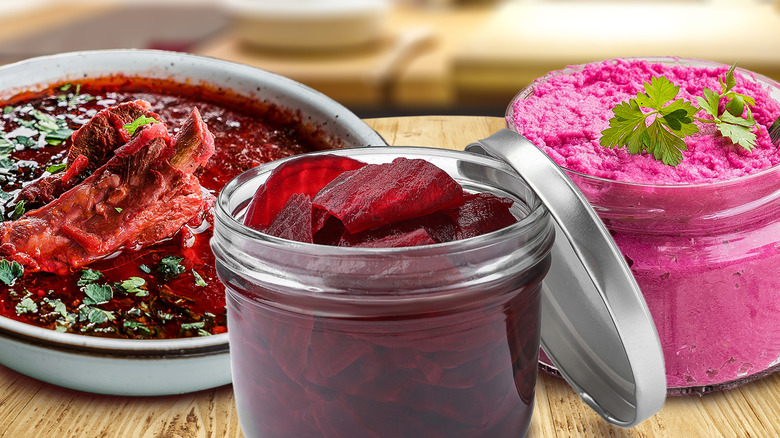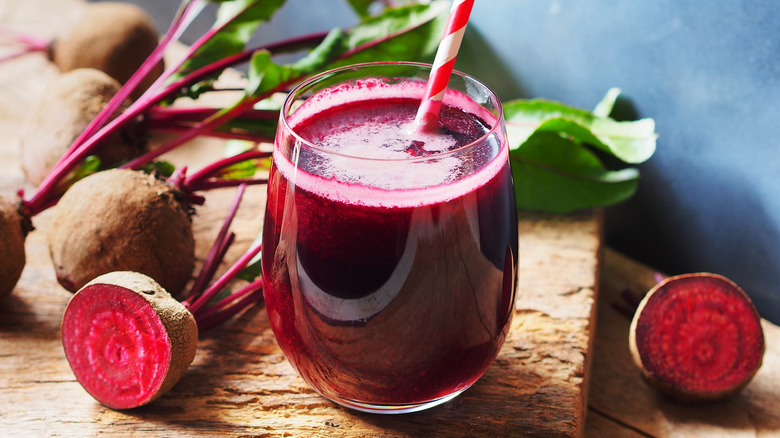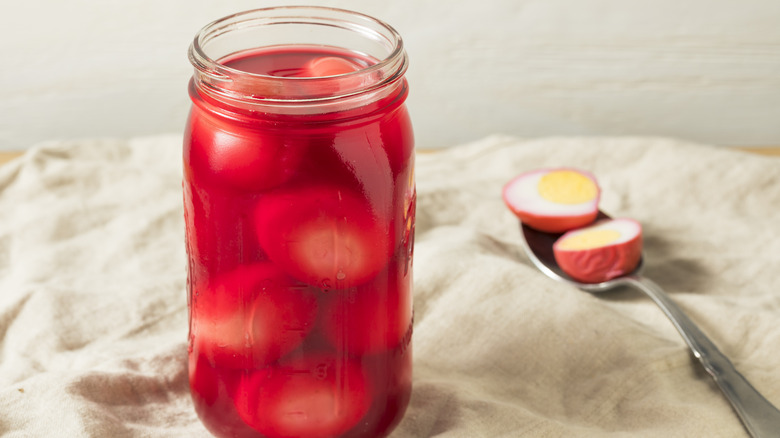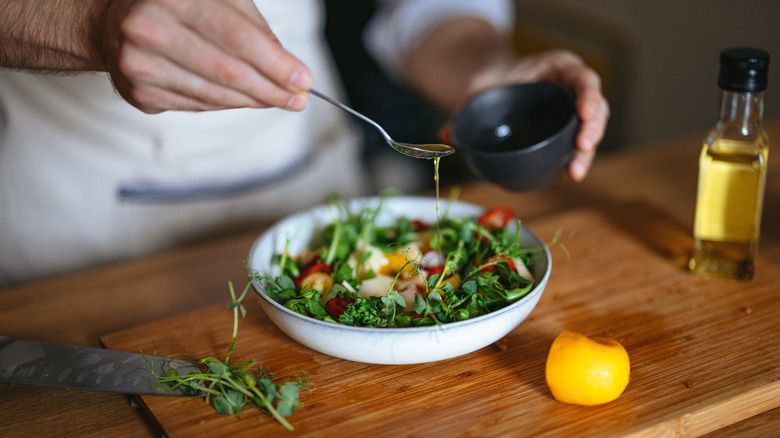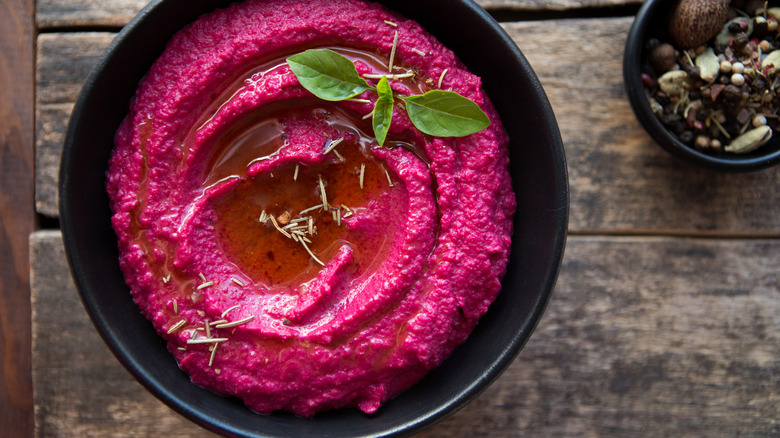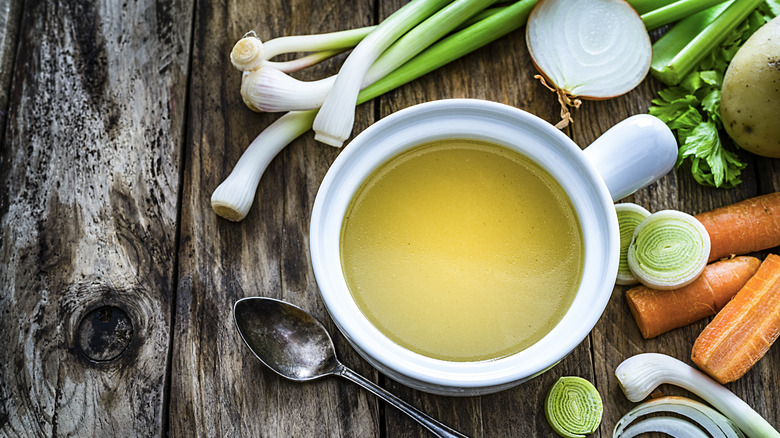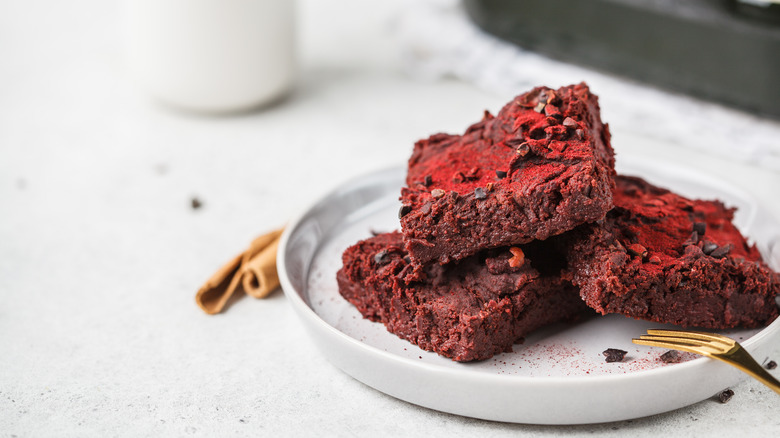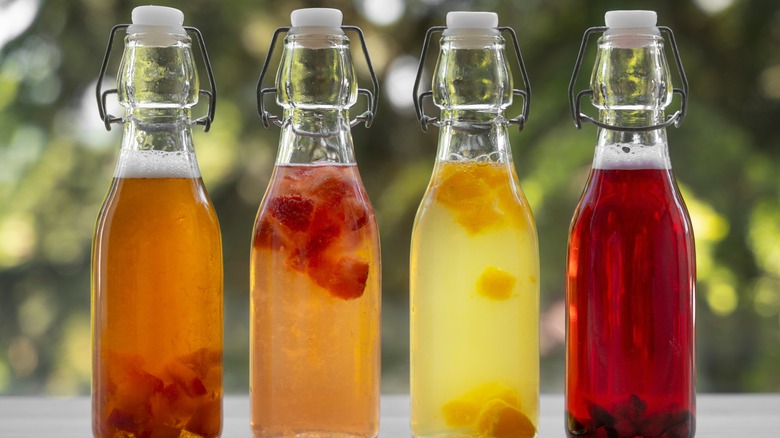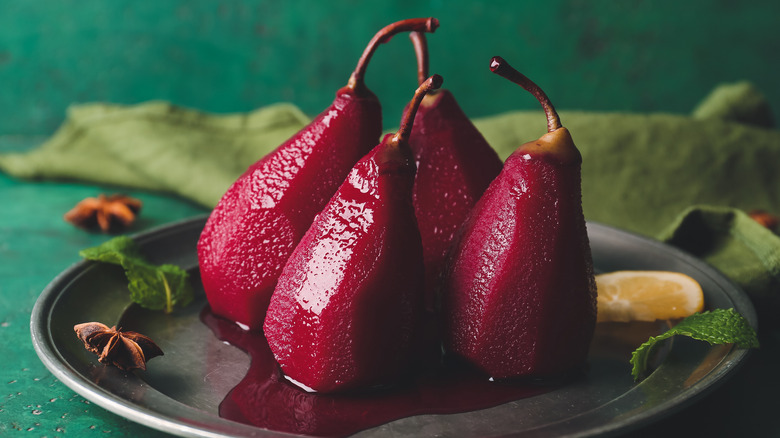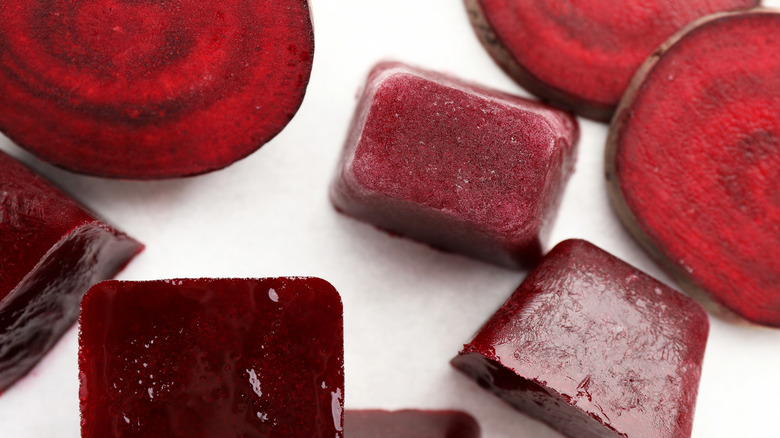12 Creative Ways To Use Liquid From Canned Beets
Somewhat of a divisive vegetable, beets tend to be dismissed on account of their slightly woody, earthy flavor, which can be unappealing to some. However, as powerhouses of nutrition, full of fiber and nutrients, beets are a great vegetable to include in your diet, even if you don't place them center stage. They can be bought fresh, but the simpler and more fuss-free option is to buy them canned. Canned beets are not only great for ease and practicality, but they also contain liquid that is a versatile and tasty ingredient, with a multitude of uses besides keeping the beets moist and fresh.
The liquid in canned beets sometimes contains added sugar or salt or vinegar if the beets are pickled, and these qualities can be worked with to produce truly tasty, complex, and intriguing flavors. Plus, the liquid will also contain trace amounts of the vitamins and minerals found in whole beets, so it's worth incorporating it into your dishes for a little extra boost of nutrition.
If you like the taste of beets, there are multiple ways to bring their unique flavor to the forefront of your dishes by using leftover beet juice. But if you find that the taste can sometimes be less than palatable, there are also ways to use up the liquid without drawing attention to its taste or altering the flavors of your food. From food coloring to fizzy kombucha, here are 12 ways to get creative with leftover beet juice.
Add it to smoothies
With their subtle earthy sweetness and inviting vibrant color, beets are the ideal addition to smoothies for both a nutrition and flavor boost, pairing incredibly well with virtually any ingredient. Also, when beets are combined with bolder flavors, it's able to go undetected for those who are not too keen on root vegetables in their smoothies. A more subtle way, however, to introduce some of these nutrients, attractive striking hue, and nuanced earthy taste into your smoothies is to use the leftover liquid from canned beets.
Adding this liquid helps to keep your drink silky smooth and reduces the risk of grittiness or roughage that can sometimes wrongfully be associated with beets. The juice can be added in addition to your regular liquids, for a tasty power-up, or substituted in place of water or your milk of choice entirely, for something a little different that packs a punch. Whether or not the beet juices you are using contain added sugar or salt will dictate what you may need in your smoothie to ensure a well-rounded drink.
Liquid with sugar will lend a sweetness to your smoothie that is particularly helpful if you are looking to counter some of the bitterness of a green smoothie without overpowering or oversweetening any existing ingredients. Meanwhile, liquid that contains vinegar or salt will likely need to be incorporated alongside a natural sweetener, such as honey or agave syrup, to ensure balance.
Pickle eggs with it
Tart and tangy, pickled eggs remain a popular, no-fuss choice of high-protein snack for many, favorable for their versatility and longevity. Indeed, pickled eggs are ideal for healthy, high protein grazing or as the base for deviled eggs, as well as a tasty and hearty addition to salads. Whilst almost all pickling solutions will begin with water, vinegar, and a pinch of sugar, the juices you use to pickle your hard-boiled eggs can be customized to suit the purpose of the end result. Additions such as chilies, capers, and garlic impart their signature flavors into the eggs for even more tasty results, but beet juice is arguably best suited for the job.
Pickling your eggs in beet juice gives them an attractive pink hue that brings vibrancy to salads and side dishes, alongside a heightened tanginess and subtle sweetness for the ideal combination of flavors. Moreover, the liquid from canned beets sometimes contains vinegar, sugar, and salt, so you've immediately got a great base for pickling liquid without the need for many extra ingredients. Simply combine the beet juice with vinegar, using equal measures of both, and, if necessary, salt or sugar, depending on the existing quantities and your taste preference, alongside any additional ingredients. Boil the liquid in a saucepan, allowing the sugar to dissolve, before pouring it over hard-boiled eggs and sealing the eggs in a suitable jar.
Use it as natural food coloring
Whether it's red velvet cake or silky smooth frosting ready to be loaded onto cupcakes, there are some foods that truly benefit, and even derive their reputation and signature look, from an inviting ruby-red color. However, some artificial food colorings, such as red dye 40, have proven to be a subject of debate and controversy, with some links being made to adverse health and behavioral effects. Whilst the extent of the risk is not entirely clear, it's best to avoid consuming artificial additives in favor of natural alternatives where possible, and beet juice provides a striking result that is by no means a sub-par substitution.
A few drops of beet juice added to cake mix grants a deep and rich red tone without drastically impacting the mixture's taste or texture. Likewise, a trickle can be beaten into frosting or glazes to give them an attractive vibrancy while also lending a slight woodiness that can help offset cloyingly sweet frosting without overpowering it. Not only does it look great, but beet juice lends its health benefits to cake mixes and frosting for a slightly more nutritious mid-afternoon pick-me-up.
Make salad dressing
Salad dressings, whether creamy and indulgent like ranch or blue cheese dressing, or slightly more subtle like vinaigrette and balsamic-based variations, add a delicious extra dimension to your bowl, and can be customized to complement your salad ingredients, or a great way to use up leftover condiments. Conveniently, the leftover liquid from canned beets serves as the perfect base for a fresh and tangy vinaigrette that lends a touch of tartness and understated sweetness.
To make a beet vinaigrette using your leftover liquid, combine it with balsamic vinegar, olive oil, a small amount of your sweetener of choice, and salt and pepper. Optional additions include garlic, citrus juice, or fresh herbs for even more flavor, but the nuanced taste of the beet liquid undoubtedly holds its own to create a tasty dressing that requires minimal additions and minimal effort, coming together in less than five minutes.
You will likely find that such a dressing complements a vast array of salad ingredients, and can also be drizzled over vegetables before roasting for a delicious sweet and tangy glaze, but beets pair particularly well with leafy, peppery greens such as spinach and rocket, as well as tart cheeses like goat cheese and feta.
Mix it into spreads
Beet juice, when combined with a few other simple ingredients, can produce truly delicious and colorful spreads, ideal for perking up your regular afternoon sandwich, swapping out your traditional avocado toast for a bolder start to the day, or dipping toasted pitta into for a moreish but nutritious snack. Liquid from canned beets with added sugar can even be used to create jams and conserves, and be further sweetened up with warming spices such as cinnamon and nutmeg.
For a creamy spread that guarantees of indulgence, and can be paired with either sweet or savory accompaniments, combine beet liquid with cream cheese, a little yogurt, a squeeze of lemon juice, and any sweetener and fresh herbs to taste. The result is a beautifully thick and creamy spread with an appetizing pink color that is sure to brighten up sandwiches and bread.
Likewise, for a vibrant take on a classic, add a little beet juice to hummus. Beets lend themselves perfectly to hummus for a colorful and earthy spin on the popular savory spread that is sure to invite even the lesser adventurous eaters, and the liquid from canned beets offers the opportunity to make this variation even speedier and slightly more subtle. If you are making hummus from scratch, you can add the liquid to chickpeas, tahini, and olive oil and blend everything until it reaches your desired consistency, adding the liquid in increments to ensure the spread does not become watery.
Swirl it into sauces and stews
With its earthy richness and subtle floral notes, the flavor of beets is ideal for adding dimension to sauces and stews without completely overpowering pre-existing flavors. Tomato-based sauces, which parallel the sweet and savory flavor combination of beets, are given extra depth and richness through the addition of beet juice, whilst creamy options, such as alfredo or béchamel, are granted a tangy sweetness and sharpness for an excellent contrast. Creamy sauces also completely take on the signature bright color of beet juice, which makes for truly eye-catching pasta dishes, well suited for special occasions or to impress your guests.
The nutty earthiness and signature tartness of beet juice also grant a complexity to virtually any sauce or stew, imparting a tantalizing sweetness onto tender meats and complementing the nuanced taste of tangy ingredients such as capers or olives and peppers, like in classic chicken cacciatore. Depending on your desired outcome, you may want to work slowly, adding the liquid a little at a time. The taste can become overwhelming in large quantities, with a propensity to drown out other, more delicate flavors, and it is a little tricky to salvage a sauce that has become overpowered by the beet juice.
Substitute it in for stock
Alongside acting as a tasty addition to sauces and stews, beet juice can also be used in place of stock entirely for a new and interesting way to enjoy favorites, as well as form the base for traditional recipes that center around their signature taste. For example, you can swap out your regular beef or vegetable stock in dishes such as chili or ratatouille to imbue them with a different and exciting new taste or consider cooking your rice in a combination of water and beet liquids for a juicy and colorful base to salad bowls and rice dishes.
The liquid from canned beets can also be used in place of stock to create a sharp and nutritious soup that offers something far bolder than your more typical vegetable broths, though you may want to reserve a little vegetable or meat-based stock to combine with the juice for a more subdued taste. A well-balanced mix of salty stock and punchy beet juice is a winning combination and at the heart of classic Ukrainian soup, borscht. A hearty and striking dish including beef or pork stock, beets, and vegetables such as cabbage or potatoes, you can make borscht at home and substitute whole beets for beet juice, being mindful to adjust the quantities of other liquids to avoid the soup becoming watery.
Add it to desserts
Though root vegetables may not be the first thing that comes to mind when you think about the ingredients for a decadent chocolate cake or chewy, fudgy brownies, beets provide sweetness and moisture to chocolate-flavored baked goods, and the liquid from canned beets serves the same purpose, minus the need for messy prep.
Part of the reason that beet juice works so well in dessert and baking recipes is that beets are naturally sweet, being higher in natural sugar than most vegetables, which makes them well-suited to blending into recipes that feature chocolate, fruit, or other sources of sugar. This relatively high sugar content, however, does not render beet juice unhealthy or an unwanted addition to such recipes. On the contrary, the naturally occurring sugars in beets do not have a significant impact on blood sugar levels, making beet juice a healthy alternative for at least a portion of more conventional caster sugar when baking.
Additionally, the liquid from canned beets, which has a purpose of keeping things stable, can help your bakes stay fresh and moist for longer. The vinegar in the liquid acts as a preservative, so you're even less likely to end up with any food waste.
Turn it into kombucha
Despite what you might think, making kombucha at home is not massively complicated and does not require the need for specialist equipment or expensive tools. With a little guidance, you can make your own creations from scratch, regardless of your level of kombucha knowledge, for a fun and rewarding experience. Once you have the basics down, you can experiment with various additions and flavors to create highly personalized and tasty variations, with beet juice offering itself as the perfect addition.
Indeed, the health benefits and vibrant color of beets make for an all-round impressive kombucha, and their flavor profile perfectly complements the fizzy, tart, borderline sweet taste of fermented kombucha for guaranteed harmony. You'll want to add the beet juice to the kombucha at the second fermentation stage, which is when the kombucha begins to bubble up, alongside any other additions, such as various herbs or ginger, with the latter pairing particularly well with beets for the ideal balance of spice and mellowness.
Poach fruit in it
Poached fruit is a classic and simple but undoubtedly delicious dessert that requires very few ingredients easily adapted to suit what you have to hand. The juicy and sweet fruit can be eaten as is, with a dollop of cream for added luxury or used as a topping for pies and tarts for an extra touch of decadence. Traditionally, fruit is poached in a sugar syrup, which is also commonly flavored with spices such as cinnamon or citrus juice and zest, but you can poach your fruit in a variety of liquids to imbue them with a designated flavor. Beet juice, with its floral notes and natural sugars, is the perfect liquid to poach your fruit in if you're looking for subtle sweetness but also some variety.
If necessary, you can sweeten up the liquid with warming spices and extra sugar to achieve a similar end result as you would when using sugar syrup, although with added color and more earthy, woody undertones. However, a slightly less sweet version ultimately gives you more options, and fruit poached in the liquid from beets can be both implemented into desserts or added to savory tarts and pastries to provide a sweet and punchy edge for a truly balanced flavor profile and a luxurious texture.
Add a splash to cocktails
When you think of beet juice in drinks, you're probably most likely to imagine green smoothies and drinks curated for sports nutrition, but beet juice actually lends itself well to cocktails. Indeed, offering a more subtle earthiness for cocktails with an arguably more refined taste than sweeter classics like the pina colada and strawberry daiquiri, beetroot juice has a woodiness that pairs particularly well with aromatic and herbaceous spirits, such as pisco, although it will also not find itself out of place in many bar classics.
Indeed, the complexity of a negroni is only heightened by the boldness of beetroot, which tastes a little sweeter when infused with gin, and the juice also gives the drink a beautiful color. Likewise, bourbon-based cocktails such as a whisky sour or an old fashioned benefit from an extra source of zestiness, with beet juice serving as the perfect addition to complement the sharpness of these sophisticated classics.
You can use the liquid from canned beets in cocktails regardless of whether it is plain, salted, or contains added sugar. In fact, even if your beet juice contains vinegar, it can be used in piquant and savory cocktails such as a bloody Mary, where it will feel right at home and ensure a sharp but nonetheless smooth sip.
Freeze it into cubes
Though there are a multitude of ways to use up canned beet juice, sometimes it can be hard to implement it into dishes instantly. Not only is an open can of bright red liquid a recipe for a mess, but decanting half-full cans of juice into jars is also time-consuming and doesn't offer much flexibility. When you have excess beet juice but no means of using it up straight away, simply pour the juice into ice cube trays and allow them to freeze.
When you need to use it, you can add a cube or two to stews and chillis for an extra kick, or use the cubes in fruity drinks such as lemonade for a refreshing twist and a pop of color. In a similar vein, you can pour the beet juice into ice pop molds, sweetened with honey, or combined with fruit, and pop them in the freezer for a lighter and less sickly sweet take on a cooling summer classic.
